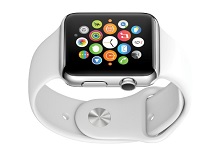

Smart Watches: Do You Value Form or Function?
Nov 5, 2014 7:05 PM, By Jason Bovberg
You might have heard that a little startup company called Apple is set to release a wearable-tech device called the Apple Watch in 2015. The recent announcement came on the heels of several evolutionary steps in the wearable-tech market from such companies as LG, Motorola, Samsung, and Sony. And that’s what Apple does best: Recognize a nascent technology, wrap it up in sleek Apple packaging, and make a fortune. But as I watched this particular Apple announcement, I simply couldn’t imagine the Apple Watch exploding the way other Apple products have.
In an interesting move, Apple has taken the course of creating a smartwatch that’s a fashion product. Some tech prognosticators are insisting that this direction is what will make all the difference, and I’m probably silly to doubt Apple’s mindset, but to me, the idea of creating a high-tech wristwatch seems to go against the trajectory of the market.
Even I—the incurable nostalgic who still plays LPs and who treasures real books—tossed my wristwatch ages ago. (It happened about the time I jettisoned the cassette tape.) In the early 1990s, I went through a geeky period of carrying a pocket watch and making a show of checking analog time. I tried a nice digital wristwatch after that, for perhaps five years; it felt uncomfortable and either slid annoyingly around my wrist or pressed a near-permanent indentation into my flesh. It was bulky and impractical. For a decade after that, I simply did without and enjoyed the freedom. Then came the cell phone, and my time-checking life was complete. Today, I can glance at my phone without even turning it on, and I have the reliably correct time.
And it’s all I’ll ever need.

Even if you are the type of person who happily wears a wristwatch, you’re probably loathe to replace your little analog beauty with a computer.
But, then again, I could be very wrong. Fitness trackers are all the rage, and they’re re-introducing the entire notion of wearable tech to huge numbers of people. According to estimates, about 13 million people have purchased them (although fitness trackers are the kinds of devices that people tend to buy and then ultimately abandon). There’s no denying that the fitness craze of the 21st century has equated to a consumer who is more open to heart-rate monitors attached to their chests and wrist devices monitoring their pulse and other devices counting their steps. Is it any wonder Apple jumped at the chance to put its iOS on a high-caliber wrist band?
And yet we’re left with the reality that many more millions of people (like myself) have grown quickly accustomed to using their smartphone as their sole timepiece. Really, only a tiny percentage of the buying public has bought in to the idea of a separate smart watch. Everyone else scoffs at the idea, considering them to be at best superfluous and at worst pointless (and ridiculously expensive).
Does Apple have the right idea, going hell-bent in the direction of ridiculously expensive by fashioning a sleek, compelling accessory that can do a lot more than just monitor your pulse? Certainly it remains a hot market, with companies such as Asus, Intel, Qualcomm, and Timex joining the fray. Amazon even seems to have one in the works (although I’m not sure anyone would want their wrist on Fire—har har).
And interestingly, like Apple, a lot of these companies are going the fashion route, moving away from bulky and nerdy, striving more toward smooth and beautiful. You can get the Apple Watch in a bunch of different styles, to match your clothes or personality.
Apple, in particular, is nothing if not bold, expecting its faithful to shell out $349 for an add-on gadget that will work only with existing Apple phones (it requires iPhone 5 or later). In its proprietary way, Apple is asking that its consumers buy essentially a second smartphone for their wrist—one that will perform the same tasks: check email and texts, check social media, run apps, use voice controls, play games, monitor your fitness, and yes, give you the time. This is a device designed to replace your wristwatch. Will it hit big? Or flop?
Coming from a different direction—not meant to replace the watch but to provide a more purely fitness-band alternative for your other wrist (if you wear a watch)—is the just-released Microsoft Band. Designed primarily to monitor health and sleep patterns, it’s meant to be worn all the time. And it’s cross-platform rather than proprietary. The Band’s software platform, Microsoft Health, is available on Windows Phone, Android, and even Apple iOS, thus opening up Band to a worldwide consumer audience. And it’s nearly half the price at $199.
The Microsoft Band is an interesting contrast to the Apple Watch, and it highlights the reason for this column. What kind of device is more compelling to you? Tech consumers have so many preconceived notions about companies that it’s difficult to get past them and make a wise decision. But which makes more sense?
Personally, I feel zero interest in reacquainting my wrist with a timepiece, but the fitness band idea is attractive. I see more purpose there. The Band offers heart-rate tracking but also cool stuff like UV light monitoring, GPS tracking (without having to carry your smartphone), guided workouts, voice-controlled apps, and multi-day battery life. And yes, it will also provide access to texting and social media and other smartphone functionality. But it’s a smart alternative to a wristwatch replacement.
Where do you fall, as you consider the types of wearable tech burgeoning in the market? Apple and Microsoft seem to exemplify the two types of smartwatches available now and on the tech horizon. Do you value form over function, or function over form? Apple’s device is certainly ambitious, but Microsoft might be responding better to what people actually need.
Time will tell!
Drop me a line and let me know what the future of smart watches looks like to you.








